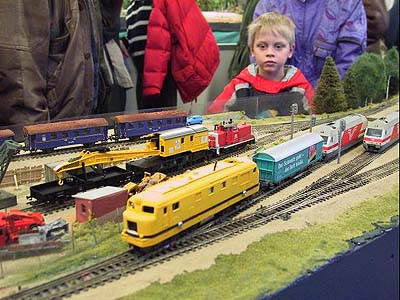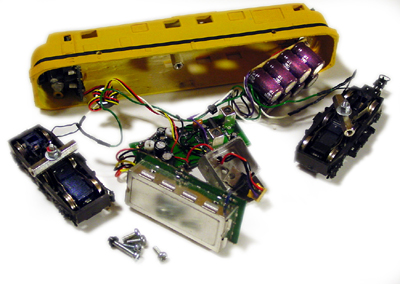TaPRK
General
Projects
Shows
Excursions
Links
Yleistä
Ratoja
Projektit
Näyttelyt
Retket
Linkit
Parish/SRK
Tapiola Parish Model Railway ClubCamera loco project |
|---|

Tapiola club has for some time now had a video loco. It was first shown at Helsinki Club's Xmas exhibition in 2000 in Helsinki.

Installing a video camera and a transmitter into a model loco is nothing new, even in Finland! Pirkanmaan rautatieharrastajien kerho PiRaKe had a video train on a layout built to State Railways some ten years ago. They used the Lionel system.
Here is a short description of the Tapiola camera loco.
The camera is an ecxcellent b/w camera (Velleman order code CAMZWA).
The salesperson at Radioduo - our major electronics component supplier - refused to sell a cheap model, as he said I'd regret it anyway. I trusted his judgement and purchased an excellent (read: expensive) b/w camera instead of cheaper colour one.
The camera's specifications may be found from link below:
- Camera in use:
- http://www.velleman.be/Product.asp?lan=1&id=19121
The camera has excellent, sharp picture and the depth of field is adequate to our purpose. The camera module's PCB needed some careful filing at top corners to make it fit inside the loco shell.
The transmitter-receiver pair is also distributed by Velleman (order code AVMOD2).
The transmitter box was 150 x 88 x 40mm in size and after (purchasing and) opening it we learned that the transmitter PCB was (if I recall right) about 110 x 80 mm in size.
After some serious hesitation the board was cut w. hacksaw in three parts, so that the PCB dipole antenna was in one part, the RF box was in one part and the rest in the last.
We discarded the antenna and replaced that with a suitable length copper wire (length calculated by my radio amateur friend) and joined the two parts with jumpers, and sandwiched the lot inside a dummy loco housing.

The specifications of the transmiter-receiver unit are found at:
- Xmitter system in use:
- http://www.velleman.be/Product.asp?lan=1&id=340485
The camera needs 12 volts, so a power supply of some sort was called for.
As we run our trains with DCC we have 14 volts ac readily in our disposal. With suitable voltage doubler circuit we got nearly 30 volts dc, and that was fed to a bank of capacitors (2 x 4000 uF) and the lot was connected to a 12 volt 7812 regulator (w. small ceramic caps to prevent the regulator from oscillating). The regulator is fastened to the loco's whitemetal fuel tank, so the tank now works as a heatsink.
The loco housing is a urethane casting of Dr12 loco from Mallijunat. I modified it by moving the cabs outward some 6mm to make it more like the Dr15 test loco as there was too little room for the camera. This Dr15 type proto was often seen attached to another loco in case it would break down en route, so it was convenient to doublehead it with a "working" loco.
It was soon apparent that we needed a battery backup, as the loco pickup was not satisfactory especially at higher speeds.
We have two 9 volt batteries inside a "Transwaggon" car and a wire going over the actual loco to camera loco. The batteries and the pickup feeders have diodes so that in case track pickup goes below battery voltage the batteries step in.
At Lahti exhibition 16th-17th Nov. 2002 we saw another camera fitted inside a train. This was based on our recearch and development but was made with commercial intent (bult to order for a customer). Only after persistent quering we were shown the insides of this setup. The parts of the transmitter were located horisontally, and the camera was a colour camera. Power supply relied solely on rechargeable batteries and the antenna was a round horisontal disk. The setup was packed into two closely coupled covered vagons, so there was no need to draw the feed wire over the loco (less noise from loco).
At Helsinki MRC's X'mas exhibition 23th--24th Nov. 2002 we had our setup slightly modified: Mr Kimmo Lumirae had lend us a colour camera that was in some respects superior to ours: it only required 5 volts to operate, and only consumes approx 10 mA. This way the consumption of the camera loco was nearly halved. The picture is slightly soft, but the electrical properties made it superior to our own. Current pickup springs were removed, yet the metal wheels are sitill in place (we have been adviced by the Stockholm Model Railway club to try plastic wheel so reduce interference). All in all, the loco now allways needs the batteries. We used GP's 1600mAh cells, 8 of those, and they provide enough current to run the camera for two day exhibition! The capacitors were removed, and the space was taken up by ground plane and a coaxial cable is taken from the transmitter to the centre of this plane and a suitable metal pin is stuck inside the coax cable to act as antenna. (there is no difference in picture quality with or without the pin;)
The transmission quality is slightly better now, as the drooping voltage does not ruin the camera picture quality. The worst cases were related to undervoltage, the old camera required 12 volts. We still get intermitted noise, but there is no detoriationg or deforming of the picture, as those were now clearly due to the camera not tolerating voltage drop.
Advice and good ideas are always welcome!
9146 kävijää/visitors
© 1996-2023 Tapiola Parish Model Railway Club / Tapiolan seurakunnan pienoisrautatiekerho, Viimeksi päivitetty / last modified (none). Created with Notepad.
Text, drawings and photos are protected by copyright laws. Technical solutions, methods and source code are public domain only for non commercial purpose. All development has been carried out during our free time, mainly funded from our own pocket and with non selfish goals, so the use of this material for profitable use (including construction for a friend aginst a fee) is forbidden without written permit from the club. The pages contain errors, so, if you use the data given, you do so at your own risk and responsibility. If you further develop material found on these pages you must put it on display without fee e.g. to a freely available web page. We expect a note about this also.
Pages tested with W3C validator -- didn't look good ;)
[YHTEYSTIEDOT] Älä lähetä sähköpostia!
Tekstit, kuvat ja piirokset ovat tekijänoikeuslain suojaamia. Tekniset ratkaisut, menetelmät ja lähdekoodit ovat vapaasti kopioitavissa ja hyödynnettävissä ei-kaupallisissa tarkoituksissa. Kaikki kehitystyö on tehty vapaa-aikana ja pääosin henkilökohtaisilla varoilla eikä hyötymistarkoituksessa, siksi materiaalin käyttö hyötymistarkoituksiin (sisältäen kaverille rahasta rakentamisen!) on kielletty ilman kerhon kirjallista lupaa! Sivuilla esiintyy virheitä. Jos käytät sivujen tietoja hyväksesi, teet sen täysin omalla vastuullasi. Mikäli kehität sivuilla esiettyjä ajatuksia kytkentäkaavioita tai koodia edelleen, on sinun asetettava se maksutta kaikkien saataville esimerkiksi Internetiin. Odotamme vastavuoroisesti tietoa suoritetusta edelleenkehitystyöstä.
Sivut testattu W3C validatorilla -- ei näyttänyt hyvältä ;)